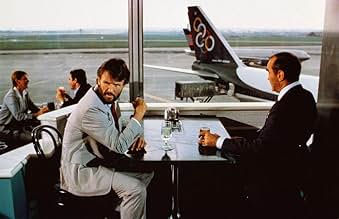Ajouter une intrigue dans votre langueJake died in Vietnam; his family mourned him, then moved on. When he reappears, quite alive, the question is, what must he do and how will his family respond to him?Jake died in Vietnam; his family mourned him, then moved on. When he reappears, quite alive, the question is, what must he do and how will his family respond to him?Jake died in Vietnam; his family mourned him, then moved on. When he reappears, quite alive, the question is, what must he do and how will his family respond to him?
John Marshall Jones
- Dwayne
- (as J.J.)
Histoire
Le saviez-vous
- AnecdotesThis was the final film directed by Franklin J. Schaffner before his death on July 2, 1989 at the age of 69. He died more than two months before it was released.
- Bandes originalesWelcome Home, Welcome Home
(theme song)
Music by Henry Mancini
Lyrics by Alan Bergman & Marilyn Bergman
Sung by Willie Nelson
Commentaire à la une
Seventeen years after his remains were supposedly delivered to the United States, Kris Kristofferson returns to the United States from his refuge in Thailand, where he had built a new life. His wife, Jobeth Williams, has married Sam Waterston, and his son, Thomas Wilson Brown, thinks of Waterston as his father. Kristofferson's mother has died, but his father, Brian Keith, is overjoyed. Kristofferson tries to fit back in, with the Army on his back because his return would be inconvenient.
It's Franklin J. Schaffner's last movie, released a couple of months after his death. Like many of his movies, it pits the lone outsider against a paranoia-inducing system he doesn't understand. However, unlike his earlier movies, the telling of this one is more standardized. The camerawork by Fred Koenkamp is solid but not flashy. The editing by Robert Swink is efficient. The story is carried by the actors -- but then Schaffner had always been a fine director of actors.
Still, the net result is a soap opera tinged with We-Were-Betrayed paranoia. Schaffner was held in high esteem by his peers; he was President of the Directors Guild of America at the time of his death. Yet he had become a director-for-hire on all sorts of projects that seem beneath his standards. Early on, he had directed prestigious works for TV, projects like the first version of TWELVE ANGRY MEN, PETER IBBETSON and ANTIGONE; his movies had included THE BEST MAN, PATTON and PAPILLON. By the 1980s, he was directing -- or trying to -- Luciano Pavarotti in YES, GIORGIO.
There is a cycle for a creative artist: young and full of ideas, older and in control of his craft. The fortunate retire at their peak. Those who continue the race after their time has passed seem to be worn out, their later works subject to the apologies of critics who don't seem to understand that talent, ability and opportunity are fleeting things, and Hollywood, and the applause of the audiences even more so -- especially egged on by critics, always looking for the bronzen god's clay feet. I think that Schaffner did as much with this movie as he could, but script and budget failed him. All he had left was the actors, and he got a lot out of them.
It's Franklin J. Schaffner's last movie, released a couple of months after his death. Like many of his movies, it pits the lone outsider against a paranoia-inducing system he doesn't understand. However, unlike his earlier movies, the telling of this one is more standardized. The camerawork by Fred Koenkamp is solid but not flashy. The editing by Robert Swink is efficient. The story is carried by the actors -- but then Schaffner had always been a fine director of actors.
Still, the net result is a soap opera tinged with We-Were-Betrayed paranoia. Schaffner was held in high esteem by his peers; he was President of the Directors Guild of America at the time of his death. Yet he had become a director-for-hire on all sorts of projects that seem beneath his standards. Early on, he had directed prestigious works for TV, projects like the first version of TWELVE ANGRY MEN, PETER IBBETSON and ANTIGONE; his movies had included THE BEST MAN, PATTON and PAPILLON. By the 1980s, he was directing -- or trying to -- Luciano Pavarotti in YES, GIORGIO.
There is a cycle for a creative artist: young and full of ideas, older and in control of his craft. The fortunate retire at their peak. Those who continue the race after their time has passed seem to be worn out, their later works subject to the apologies of critics who don't seem to understand that talent, ability and opportunity are fleeting things, and Hollywood, and the applause of the audiences even more so -- especially egged on by critics, always looking for the bronzen god's clay feet. I think that Schaffner did as much with this movie as he could, but script and budget failed him. All he had left was the actors, and he got a lot out of them.
Meilleurs choix
Connectez-vous pour évaluer et suivre la liste de favoris afin de recevoir des recommandations personnalisées
- How long is Welcome Home?Alimenté par Alexa
Détails
- Date de sortie
- Pays d’origine
- Langue
- Aussi connu sous le nom de
- Welcome Home - Ein Toter kehrt zurück
- Lieux de tournage
- Sociétés de production
- Voir plus de crédits d'entreprise sur IMDbPro
Box-office
- Budget
- 11 000 000 $US (estimé)
- Montant brut aux États-Unis et au Canada
- 1 029 822 $US
- Montant brut mondial
- 1 029 822 $US
- Durée1 heure 32 minutes
- Mixage
Contribuer à cette page
Suggérer une modification ou ajouter du contenu manquant

Lacune principale
By what name was Welcome Home (1989) officially released in India in English?
Répondre





























